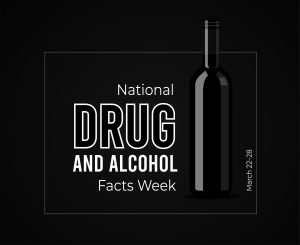 National Drug and Alcohol Facts Week is an annual observance that focuses on the discussion of drug and alcohol use and addiction among young people. The most common substances used by this group are alcohol, tobacco, and marijuana, but there is also significant use of substances such as club drugs, anabolic steroids, and opioids.
National Drug and Alcohol Facts Week is an annual observance that focuses on the discussion of drug and alcohol use and addiction among young people. The most common substances used by this group are alcohol, tobacco, and marijuana, but there is also significant use of substances such as club drugs, anabolic steroids, and opioids.
Alcohol: Approximately 29% of high school-aged young people consume alcoholic beverages, with about 14% binge-drinking and 17% driving with someone who had been drinking. Additionally, underage drinking is associated with several negative outcomes, including a higher chance of academic, social, legal, and physical problems, as well as an increased likelihood of experiencing sexual violence, suicide, homicide, or abuse of other substances.
Tobacco: Nearly 99% of people who use tobacco products daily began by the age of 26. Over 85% of high school students and 81.5% of middle school students reported using products such as e-cigarettes because of their flavors, indicating that this factor may make these products more appealing to young people.
Marijuana: The most recent statistics from the Centers for Disease Control and Prevention indicate that approximately four out of 10 high school students have used marijuana at some point in their lives. Regular usage can potentially lead to long-term health effects such as mental health disorders or marijuana use disorder, a form of addiction that approximately 30% of people who use marijuana experience.
Club drugs: The term “club drugs” refers to substances such as cocaine, ecstasy, ketamine, rohypnol, methamphetamine, and acid. They’re most often used by young adults at parties, concerts, bars, nightclubs, or other event spaces. They are generally psychoactive substances and cause changes in mood, behavior, and awareness. They are also often used as “date rape” drugs to make it easier for a person to sexually assault a victim.
Anabolic steroids: Recreational steroid usage generally begins in young adulthood, with approximately 22% of users beginning as teenagers. Steroids are most likely to be used by males who participate in sports focused on weight and shape, such as bodybuilding. They may increase the likelihood of cognitive problems, such as increased impulsivity and decreased attention, as well as heart problems.
Opioids: Approximately 14% of students report misusing prescription opioids, which are typically used as painkillers after a major injury or procedure or for the treatment of chronic pain. Opioids carry a high risk of addiction and dependence when misused, making an overdose more likely. An overdose can lead to symptoms such as drowsiness, mental fog, nausea, constipation, slowed breathing, and even death.
If a young person you know is experiencing substance abuse or addiction, Flushing Hospital Medical Center’s Division of Addiction Services can treat them through our Reflections program, which you can learn more about by calling (718) 670-5078. For more information about our 24/7 chemical dependence unit, where your loved one can experience withdrawal safely, please call (718) 670-5693 or (718) 670-5540.
All content of this newsletter is intended for general information purposes only and is not intended or implied to be a substitute for professional medical advice, diagnosis or treatment. Please consult a medical professional before adopting any of the suggestions on this page. You must never disregard professional medical advice or delay seeking medical treatment based upon any content of this newsletter. PROMPTLY CONSULT YOUR PHYSICIAN OR CALL 911 IF YOU BELIEVE YOU HAVE A MEDICAL EMERGENCY.
